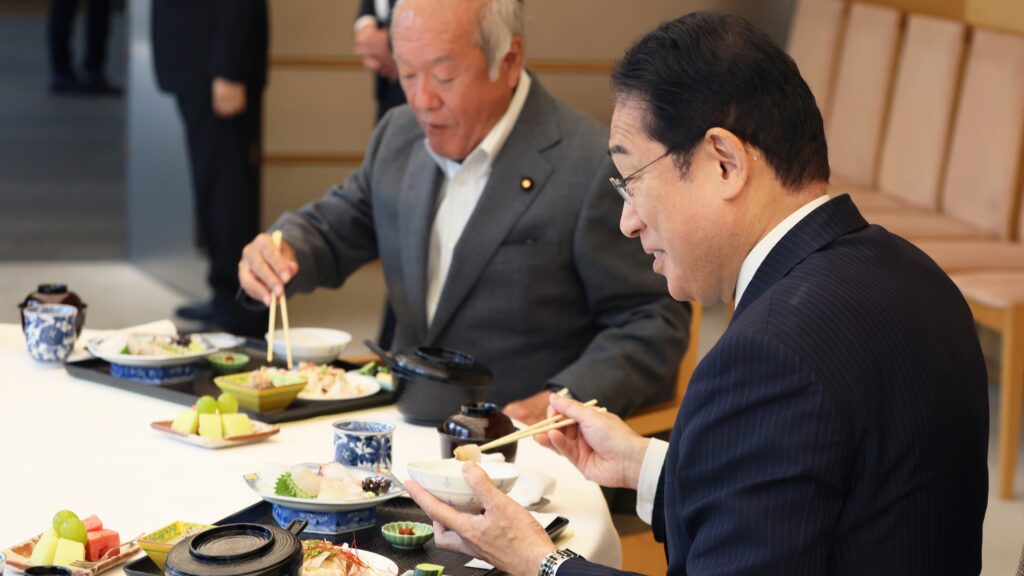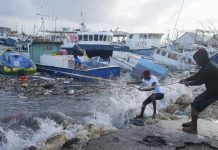By Shayal Devi
A couple of months ago, a video clip of Japanese Prime Minister Fumio Kishida eating sashimi sourced from a fish caught near the crippled Fukushima Daiichi Nuclear Power Plant, went viral.
On social media, the video drew comparisons with The Simpsons, in which businessman Mr Burns eats a three-eyed fish caught from waters nearby the scandalous Springfield Nuclear Power Plant.
One can argue that life imitates art and in this case, Mr Kishida’s very public move was one designed to show that seafood would remain safe for human consumption as treated wastewater continues to be discharged into the ocean.
Understandably, for a nation like Fiji where her people are dependent on the ocean and seafood, the idea of contamination – especially from radioactive sources – is one that has stirred up anxiety.
Even as Japanese authorities have scrambled to pass off seafood in waters off Fukushima as safe, importers of seafood in Japan’s waters remain skeptical, and some have even banned all imports.
Outside of Fukushima, independent labs and organisations have also conducted their own tests to determine radioactivity in fish after the 2011 disaster.
Among them is Dr Nicholas Fisher, a distinguished professor and director of the Consortium for Inter-Disciplinary Environmental Research at Stony Brook University, a public research university in New York.
One of Dr Fisher’s laboratory research aims is to assess the bioavailability and fate of metals, and this includes radionuclides in marine organisms.
Dr Fisher spoke to the Fiji Times newspaper on his research at Fukushima post-2011, the findings, and whether Fijians should be worried about radioactivity in seafood from the wastewater discharge.
Marine organisms analysis According to Dr Fisher, most of his work at Fukushima concluded a couple of years ago. He said the focus of this work was to examine the extent to which radionuclides released from Fukushima into the Pacific were accumulated by marine organisms.
“And so, the first study that we did just collected plankton,” Dr Fisher said.
“We collected plankton and very small fish from 20 to about several hundred kilometres offshore and we were looking for any gamma-emitting radionuclides that we could detect in any of these organisms.
“We found that all of the organisms, these were primarily copepods. It’s a type of zooplankton and the small fish, all have radioactive Cesium, Cesium 137 and also, Cesium 134, coming from Fukushima.
“The zooplankton also had radioactive Silver (Ag110m) so that research was conducted about two months after the date of the release of the radionuclides into the Pacific.”
Dr Fisher said an additional two months later, his team collected bluefin tuna caught off the coast of Southern California, near San Diego.
He explained that bluefin tuna in the Pacific spawned in waters in the Western Pacific, near Japan.
“And then, when they’re sometimes about oneyear-old, they swim across the entire Pacific Ocean to waters off California and Mexico, where they stay for several years, and they get very large.
“But when they first swim across the Atlantic, they’re not very large at all. So, we knew that any tuna that were caught off San Diego, that were big, were newly arrived tuna that had just come from Japanese waters.
“We collected 15 of them in August of 2011 and we were a little quite surprised to see that they all had radioactive Cesium, Cesium 137 and 134.
“We looked for other radionuclides in those fish. And we saw nothing. I mean, no man-made radionuclides, and so we also measured some naturally occurring radionuclides, particularly Potassium 40, which has always existed in the ocean, and all marine life has Potassium 40 in it.”
Potassium and polonium Dr Fisher explained that our bodies are radioactive with Potassium 40.
“So, when you and I were born, we were born radioactive, with Potassium, mainly Potassium 40, in our bodies,” he said.
“It’s a naturally occurring radionuclide and so we measured the natural radionuclides in the fish and compared them to the artificial radionuclides, just as we had done with plankton a couple of months earlier.
“All the plankton and all the fish had a lot of Potassium 40 in their bodies. Which was no surprise, they always had that. We were surprised, though, that bluefin tuna were already up with Cesium.”
From these findings, Dr Fisher said they inferred that the tuna acquired radioactive Cesium in waters around Japan. After this, they carried that radioactivity all the way across the Pacific Ocean.
“It takes like, one to three months, to swim across the Pacific. And they were still radioactive, with radioactive Cesium. We compared the radioactivity to the Potassium 40 in the bodies and the radioactivity of Potassium 40 was far greater than from the artificial radioactivity.
“Significantly, the dose to the marine animals was greater not from Potassium 40, but especially from Polonium 210.
“Polonium 210, the symbol is Po, is another naturally occurring radionuclide that is enriched in all seafood, has always been, before people ever existed on this planet. And it’s the last of the radioactive daughter products of Uranium 238, which is ubiquitous in the ocean.”
Dr Fisher said Polonium 210 was an alphaemitting radionuclide which, if internalised in an organism, can cause the greatest biological damage.
Additionally, he stated that the dose that one got from Polonium 210 was much greater than from Potassium 40, and much, much greater than from the radioactive Cesium that came from Fukushima.
“We published a few papers on this, mostly in Proceedings National Academy of Science in the United States. We talked about the dose that the organisms would feel from the radioactivity and the dose that human beings would get from eating that seafood.
“And the dose was far less from the Cesium than from the Polonium, which is naturally occurring. In fact, that’s less than you would get from eating bananas or Brazil nuts or any potassium rich foods.
“It’s less than you would get from a dental X-ray, less than you would get from flying in an airplane, when you’re exposed to cosmic rays.
“So, generally speaking, we were surprised to see all the tuna carrying the radioactive Cesium, but we were relieved to see that the dose was pretty low.”
Further studies Following the initial studies, Dr Fisher and his team continued to carry out further studies to see if radioactivity in tuna had increased or decreased in the tuna.
Dr Fisher said the team found the radioactivity had decreased after one year, and by the end of two years, it was almost undetectable. In addition, he said the team also looked at Japanese data which measured radioactive Cesium in fish in coastal waters around Japan.
“These are thousands of different fish samples,” Dr Fisher said.
“The Japanese found that the fish that live near the bottom of the water, near the sediments and the mud at the bottom, were more radioactive than the fish that live higher up in the surface ocean.
“We conducted experiments to try to explain that and we found this was mostly attributable to the fact that the radioactive Cesium that was released from Fukushima, a fair amount of it ended up in the sediments in the mud.
“The worms that live in those sediments acquire radioactive Cesium from the mud, they assimilate that from the mud in their tissue. There comes a little fish that eats the worm. And so, the Cesium gets transferred from the worm to the fish.
“So, the bottom-dwelling fish were more radioactive than the surface-dwelling fish. But again, the dose was probably below levels that would be dangerous to humans, seafood consumers.”
Dr Fisher said these sediments remained radioactive for a much longer period than the overlying water, thus remained a constant source of radioactivity for bottom-dwelling fish.
“The bottom-dwelling fish stayed radioactive for years after the accident, whereas the surfacedwelling fish, which picked up the radioactivity from the overlying water, were not very radioactive at all. And that was in a nutshell, that was what our studies showed.”
Manmade v natural radioactivity The subject of Fukushima has also generated a lot of debate about radioactivity, but the lines seem to be blurred when it comes to natural or manmade radioactivity.
“Human beings, like all other organisms on earth, were born into and have evolved on a radioactive planet,” Dr Fisher said, adding that about 99 per cent of radioactivity in the oceans was natural.
“It has always been in the ocean before human beings ever appeared on earth and before there were any nuclear programmes anywhere. The (manmade) radionuclides that have been introduced into the oceans since 1945, 99 per cent of it came from nuclear weapons testing, which occurred in the Pacific but other places as well. And that peaked in 1963.
“Most of the nuclear weapons testing, above ground, occurred before 1963. So even with all the accidents that have occurred, Chernobyl and Fukushima, and other accidents that you’re probably not aware of.
“As well as intentional dumping of radioactive waste by different countries, if you add it all up, that’s only 1 per cent, maybe 2 per cent of manmade radioactivity in the oceans. 98 to 99 per cent is from weapons testing.
“But 99 per cent of all the radioactivity in the oceans is natural. So, all living things have evolved on a radioactive planet and have adjusted to the natural levels of radiation that occur and dose(s) that you would get from the anthropogenic radionuclides, eating, let’s say, fish in the middle of the Pacific.”
Dr Fisher also pointed out that most of the radioactive doses that human beings got from eating food in the Pacific was from naturally occurring radioactivity, especially from Polonium 210.
“There have been many studies looking at radioactivity and seafood in the Pacific, and what I’m telling you is consistent with what they found.
“Now, in the Marshall Islands, there was nuclear weapons testing in the 1950s and early 1960s. And so, some of the seafood there remains radioactive. And the people were exposed to more radioactivity eating the local seafood there. But that’s not representative of the Pacific in general.”
Should we be worried? Dr Fisher said although he was not part of the team monitoring seafood after the release of the treated wastewater in August this year, he was “not worried” about it.
When asked to explain why, Dr Fisher said the Japanese had reportedly stripped all the radioactivity out of that nuclear wastewater, except for radioactive Hydrogen, in the form of tritium.
“Tritium is a very weak emitter, doesn’t concentrate appreciably in any marine organisms. So, it’s not a problem,” Dr Fisher said.
“The bioconcentration factor of tritium in marine organisms is one, which means that the concentration in living organisms is about the same as in the surrounding water and it’s largely harmless.
“Tritium is also a naturally produced radionuclide and produced by cosmic rays. We have evolved in the presence of tritium, all our existence. So, if the only radioactivity in those tanks is tritium, and that’s what the Japanese say, then I think disposal of that radioactive water into the Pacific is probably harmless.
“If, on the other hand, there are other radionuclides present in those tanks, and the Japanese either did not measure them or were dishonest about reporting it, then it is conceivable that it would be a problem in very localised waters, probably very close to the coast of Japan. But I think that’s unlikely.
“I understand. People, all over the world, including my country in the United States, but everywhere are terrified about radioactivity. They’re terrified about it. And if you say that same food is contaminated with artificial radioactivity, they freak out. In America, they do. Probably in Fiji and everywhere else.”
However, Dr Fisher said danger from very low levels of radioactivity was almost certainly much less dangerous than the dangers from other chemical contaminants that were certainly present in those fish, especially methyl mercury.
This, he said, was a form of mercury that was introduced into the oceans mostly from coalfired power plants, but other sources as well. According to Dr Fisher, methyl mercury bio concentrates “tremendously” up the food chain.
“And so, there are very high concentrations of methyl mercury in, say, tuna or swordfish. Most fish, the higher up the trophic level, the apex predators, have higher concentrations of mercury than sardines and anchovies, for example.
“Mercury is much more toxic than radioactivity. So, if I were going to worry about contamination and seafood, I would be more concerned about mercury and measuring mercury concentrations in the seafood than I would about the radioactivity.
“There are other non-radioactive contaminants as well. One that is just starting to get recognised, Per- and Polyfluorinated Substances (PFAS).”
PFAS is defined as a group of chemicals that are normally used to make fluoropolymer coatings and other products which are resistant to heat, water, stains, oil and grease, and is used to make clothing, furniture, adhesives, food packaging etcetera. Such contaminants, Dr Fisher reiterated, posed more of a threat as compared to naturally occurring radionuclides.
SOURCE: FIJI TIMES/PACNEWS















